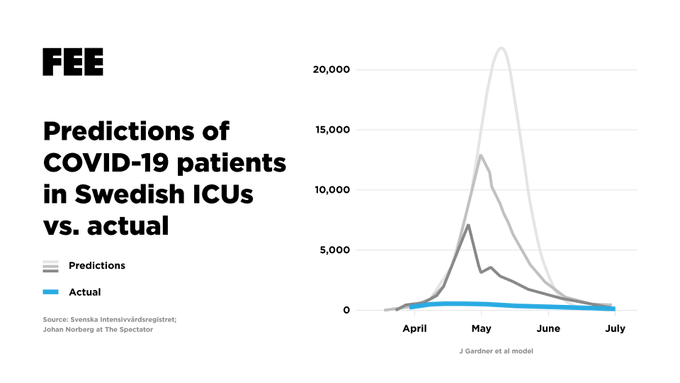
Jon Miltimore – July 30, 2020
At a press conference last week, Anders Tegnell said a massive decline in new COVID-19 cases shows Sweden’s “lighter touch” strategy is doing what it was designed to do.
“It really is yet another sign that the Swedish strategy is working,” Tegnell, Sweden’s top epidemiologist, said. “It is possible to slow contagion fast with the measures we are taking in Sweden.”
Unlike most nations in the world, Sweden avoided a hard lockdown. The nation of 10 million people instead opted for a strategy that sought to encourage social distancing through public information, cooperation, and individual responsibility. Restaurants, bars, public pools, libraries, and most schools remained open with certain capacity limits.
Sweden’s decision to forego lockdowns brought a barrage of scrutiny and criticism. Its approach was described as a “cautionary tale” by The New York Times.
But as I’ve pointed out, the criticism stemmed less from the results of Sweden’s experiment than the nature of the experiment. There are ample examples of nations (and US states) that have suffered far more from COVID-19 than Sweden even though these countries (and states) initiated hard lockdowns requiring citizens to shelter at home.
Perhaps the best way to measure the success of Sweden’s policies is to compare the outcome models predicted to the actual results.
On May 10, Dagens Nyheter—Sweden’s biggest daily newspaper—analyzed a pair of models inspired by the Imperial College of London study, which predicted as many as 40 million people could die if the coronavirus was left unchecked. The models predicted that Sweden’s ICUs (intensive care units) would expire before May and nearly 100,000 people would die from COVID-19 by July.
“Our model predicts that, using median infection-fatality-rate estimates, at least 96,000 deaths would occur by 1 July without mitigation,” the authors wrote.
It’s a frightening prediction. And perhaps that was the point.
As Johan Norberg pointed out in The Spectator back in May, these models were used by critics of Sweden’s strategy to show its healthcare system would collapse if it did not “make a U-turn into lockdown” similar to the United Kingdom.
Well, we’re nearly through July. So how do the predictions stack up against the results?
Total COVID-19 deaths in Sweden stand at 5,700, nearly 90,000 less than modelers predicted. Hospitals were never overrun. Daily deaths in Sweden have slowed to a crawl. The health agency reports no new ICU admissions.

As the chart above shows, modelers weren’t just wrong. They weren’t even remotely close.
How did the experts get it so wrong? There are many reasons, of course, including the fact that COVID-19 isn’t as deadly as modelers originally feared. The simplest answer, however, is that modelers overlooked a basic reality: humans spontaneously alter their behavior during pandemics.
This should not be a surprise. Humans are intelligent, instinctive, and self-preserving creatures who will seek to avoid high-risk behavior. The natural law of spontaneous order shows that humans naturally adapt their behavior when circumstances warrant it. (In his 1988 book The Fatal Conceit, the economist F.A. Hayek described this process as “the least appreciated facet of human evolution.”)
Scientific evidence, as it relates to the current pandemic, bears out this economic idea. Research shows that in the US, workplaces and consumers changed their travel patterns before governments began issuing stay-at-home orders. In other words, without being ordered or even instructed, tens of millions of Americans were already adapting their behavior to the unknown threat of COVID-19.
A similar experience took place in Sweden, where foot traffic and train traffic were sharply reduced without draconian orders and penalties.
“We actually made a comparison to our Nordic neighbors, and the Swedish travel patterns have changed just as much as our Nordic neighbors, in spite of them having much more legal lockdowns than we have,” Tegnell said in a May interview.
The Swedish experience is important. As Phil Magness has noted at AIER, Sweden’s success suggests the presumed risks and benefits of lockdowns were largely a fiction.
“[T]he assumed benefits of a more severe lockdown policy appear to have been greatly exaggerated,” Magness wrote. “The assumed risks of the milder course adopted by the Swedish government appear to have been similarly inflated. And the overall death toll of the baseline ‘do nothing’ scenario appears to have little grounding in reality.”
One might argue that caution was warranted given the unknown threat of COVID-19. This argument is less persuasive when the costs of the lockdowns—a looming global recession, hundreds of millions of jobs lost, millions of businesses shuttered, historic social unrest, surging extreme poverty, and widespread health deterioration—are taken into account.
Fortunately, it’s not too late to learn from our mistakes. First, however, we must acknowledge them.
Originally published at Fee.org. Jonathan Miltimore is the Managing Editor of FEE.org. His writing/reporting has been the subject of articles in TIME magazine, The Wall Street Journal, CNN, Forbes, Fox News, and the Star Tribune. Bylines: The Washington Times, MSN.com, The Washington Examiner, The Daily Caller, The Federalist, the Epoch Times.
Image Credit: CNN